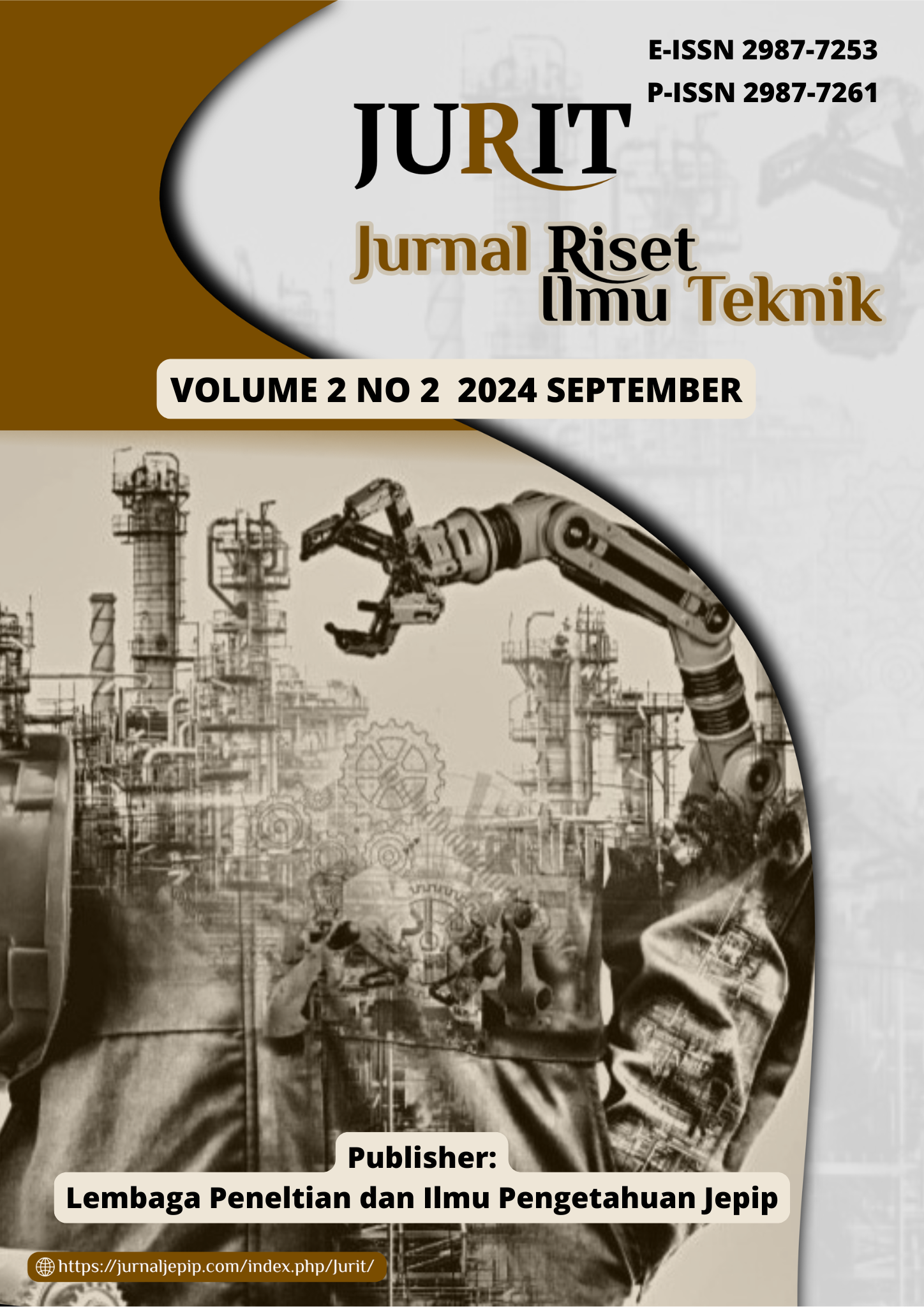Synergistic Effects of Gypsum and Cement on the Geotechnical Properties of Clay Soils: Experimental Evaluation of CBR, UCS, and Compaction Characteristics
DOI:
https://doi.org/10.59976/jurit.v2i2.89Abstract
Expansive clay soils are widely recognized as problematic subgrade materials due to their high plasticity, low strength, and pronounced swelling–shrinkage behavior. This study investigates the synergistic effect of gypsum and cement as stabilizing agents for clay soils. Laboratory tests were conducted on 96 soil specimens, with stabilizer contents of 1%, 3%, and 5% (by dry weight) and curing periods of 1, 7, and 14 days. Standard tests, including Atterberg limits, compaction, California Bearing Ratio (CBR), and Unconfined Compressive Strength (UCS), were performed according to ASTM/SNI standards. Results demonstrate that the combined use of gypsum and cement significantly reduces the plasticity index from 41.54% to 8.35% and increases CBR from 1.99% to 23.65% after 14 days of curing. UCS values also improved, reaching a peak of 1.84 MPa under optimum stabilization conditions (5% additive, 14 days curing). These improvements are attributed to cation exchange and pozzolanic reactions that form calcium silicate hydrate (C–S–H) and calcium aluminate hydrate (C–A–H) phases, enhancing soil particle bonding and reducing voids. The findings indicate that combined gypsum–cement stabilization is not only effective in improving mechanical properties but also modifies the soil classification from high plasticity clay (CH) to low plasticity clay (OL). This research contributes practical guidelines for road subgrade improvement and advances the scientific understanding of chemical–mineral interactions in soil stabilization.
References
S. Nanda, “Municipal solid waste management and landfilling technologies: a review,” 2021. doi: 10.1007/s10311-020-01100-y.
D. Barman, “Stabilization of expansive soils using chemical additives: A review,” 2022. doi: 10.1016/j.jrmge.2022.02.011.
T. Raza, “Unrevealing the potential of microbes in decomposition of organic matter and release of carbon in the ecosystem,” 2023. doi: 10.1016/j.jenvman.2023.118529.
A. Almajed, “State-of-the-art review of the applicability and challenges of microbial-induced calcite precipitation (Micp) and enzyme-induced calcite precipitation (eicp) techniques for geotechnical and geoenvironmental applications,” 2021. doi: 10.3390/cryst11040370.
S. Joseph, “How biochar works, and when it doesn’t: A review of mechanisms controlling soil and plant responses to biochar,” 2021. doi: 10.1111/gcbb.12885.
P. Song, “Recent advances in soil remediation technology for heavy metal contaminated sites: A critical review,” 2022. doi: 10.1016/j.scitotenv.2022.156417.
F. A. Dijkstra, “Root effects on soil organic carbon: a double-edged sword,” 2021. doi: 10.1111/nph.17082.
Y. Sun, “Roles of biochar-derived dissolved organic matter in soil amendment and environmental remediation: A critical review,” 2021. doi: 10.1016/j.cej.2021.130387.
H. Wu, “Unveiling the crucial role of soil microorganisms in carbon cycling: A review,” 2024. doi: 10.1016/j.scitotenv.2023.168627.
D. M. Xu, “Chemical stabilization remediation for heavy metals in contaminated soils on the latest decade: Available stabilizing materials and associated evaluation methods-A critical review,” 2021. doi: 10.1016/j.jclepro.2021.128730.
A. L. Alvarez, “Microalgae, soil and plants: A critical review of microalgae as renewable resources for agriculture,” 2021. doi: 10.1016/j.algal.2021.102200.
M. Kumar, “Remediation of soils and sediments polluted with polycyclic aromatic hydrocarbons: To immobilize, mobilize, or degrade?,” J. Hazard. Mater., vol. 420, 2021, doi: 10.1016/j.jhazmat.2021.126534.
E. D. Whalen, “Clarifying the evidence for microbial- and plant-derived soil organic matter, and the path toward a more quantitative understanding,” 2022. doi: 10.1111/gcb.16413.
M. E. Craig, “Fast-decaying plant litter enhances soil carbon in temperate forests but not through microbial physiological traits,” Nat. Commun., vol. 13, no. 1, 2022, doi: 10.1038/s41467-022-28715-9.
Z. R. Kan, “Mechanisms of soil organic carbon stability and its response to no-till: A global synthesis and perspective,” 2022. doi: 10.1111/gcb.15968.
L. Wang, “A review of green remediation strategies for heavy metal contaminated soil,” 2021. doi: 10.1111/sum.12717.
Y. Wang, “Effects of exposure of polyethylene microplastics to air, water and soil on their adsorption behaviors for copper and tetracycline,” Chem. Eng. J., vol. 404, 2021, doi: 10.1016/j.cej.2020.126412.
J. Huang, “A state-of-the-art review of polymers used in soil stabilization,” 2021. doi: 10.1016/j.conbuildmat.2021.124685.
R. A. Dickman, “A review of recent studies on toxicity, sequestration, and degradation of per- and polyfluoroalkyl substances (PFAS),” 2022. doi: 10.1016/j.jhazmat.2022.129120.
R. Agnihotri, “Glycoproteins of arbuscular mycorrhiza for soil carbon sequestration: Review of mechanisms and controls,” 2022. doi: 10.1016/j.scitotenv.2021.150571.
E. S. Button, “Deep-C storage: Biological, chemical and physical strategies to enhance carbon stocks in agricultural subsoils,” 2022. doi: 10.1016/j.soilbio.2022.108697.
M. F. Cotrufo, “The role of plant input physical-chemical properties, and microbial and soil chemical diversity on the formation of particulate and mineral-associated organic matter,” Soil Biol. Biochem., vol. 168, 2022, doi: 10.1016/j.soilbio.2022.108648.
Z. Xu, “Removal and generation of microplastics in wastewater treatment plants: A review,” 2021. doi: 10.1016/j.jclepro.2021.125982.
G. H. Yu, “Fenton chemistry and reactive oxygen species in soil: Abiotic mechanisms of biotic processes, controls and consequences for carbon and nutrient cycling,” 2021. doi: 10.1016/j.earscirev.2021.103525.
Y. Yang, “Biochar stability and impact on soil organic carbon mineralization depend on biochar processing, aging and soil clay content,” Soil Biol. Biochem., vol. 169, 2022, doi: 10.1016/j.soilbio.2022.108657.
J. Qu, “Stabilization of lead and cadmium in soil by sulfur-iron functionalized biochar: Performance, mechanisms and microbial community evolution,” J. Hazard. Mater., vol. 425, 2022, doi: 10.1016/j.jhazmat.2021.127876.
L. Chen, “Soil carbon persistence governed by plant input and mineral protection at regional and global scales,” Ecol. Lett., vol. 24, no. 5, pp. 1018–1028, 2021, doi: 10.1111/ele.13723.
K. M. Buckeridge, “Deconstructing the microbial necromass continuum to inform soil carbon sequestration,” 2022. doi: 10.1111/1365-2435.14014.
H. Miraki, “Clayey soil stabilization using alkali-activated volcanic ash and slag,” J. Rock Mech. Geotech. Eng., vol. 14, no. 2, pp. 576–591, 2022, doi: 10.1016/j.jrmge.2021.08.012.
L. Wei, “Comparing carbon and nitrogen stocks in paddy and upland soils: Accumulation, stabilization mechanisms, and environmental drivers,” Geoderma, vol. 398, 2021, doi: 10.1016/j.geoderma.2021.115121.
W. Beinart, The Rise of Conservation in South Africa: Settlers, Livestock, and the Environment 1770-1950. 2023. [Online]. Available: https://www.scopus.com/inward/record.uri?partnerID=HzOxMe3b&scp=85194516609&origin=inward
Y. Yang, “Increasing contribution of microbial residues to soil organic carbon in grassland restoration chronosequence,” Soil Biol. Biochem., vol. 170, 2022, doi: 10.1016/j.soilbio.2022.108688.
T. Cai, “Silicate-modified oiltea camellia shell-derived biochar: A novel and cost-effective sorbent for cadmium removal,” J. Clean. Prod., vol. 281, 2021, doi: 10.1016/j.jclepro.2020.125390.
S. Han, “Soil aggregate size-dependent relationships between microbial functional diversity and multifunctionality,” Soil Biol. Biochem., vol. 154, 2021, doi: 10.1016/j.soilbio.2021.108143.
I. G. Lopes, “Frass derived from black soldier fly larvae treatment of biodegradable wastes. A critical review and future perspectives,” 2022. doi: 10.1016/j.wasman.2022.02.007.
S. Liu, “Status and environmental management of soil mercury pollution in China: A review,” 2021. doi: 10.1016/j.jenvman.2020.111442.
I. Kögel-Knabner, “Soil organic matter in major pedogenic soil groups,” Geoderma, vol. 384, 2021, doi: 10.1016/j.geoderma.2020.114785.
C. Mejías, “Occurrence of pharmaceuticals and their metabolites in sewage sludge and soil: A review on their distribution and environmental risk assessment,” 2021. doi: 10.1016/j.teac.2021.e00125.
M. X. Li, “Influence of moisture content on chicken manure stabilization during microbial agent-enhanced composting,” Chemosphere, vol. 264, 2021, doi: 10.1016/j.chemosphere.2020.128549.
X. Song, “Towards a better understanding of the role of Fe cycling in soil for carbon stabilization and degradation,” 2022. doi: 10.1007/s44246-022-00008-2.
Downloads
Published
How to Cite
Issue
Section
License
Copyright (c) 2024 Basral Anugrah, Haiban Haiban

This work is licensed under a Creative Commons Attribution 4.0 International License.





















